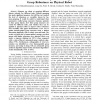Free Online Productivity Tools
i2Speak
i2Symbol
i2OCR
iTex2Img
iWeb2Print
iWeb2Shot
i2Type
iPdf2Split
iPdf2Merge
i2Bopomofo
i2Arabic
i2Style
i2Image
i2PDF
iLatex2Rtf
Sci2ools
ICRA
2010
IEEE
2010
IEEE
Human-guided grasp measures improve grasp robustness on physical robot
— Humans are adept at grasping different objects robustly for different tasks. Robotic grasping has made significant progress, but still has not reached the level of robustness or versatility shown by human grasping. It would be useful to understand what parameters (called grasp measures) humans optimize as they grasp objects, how these grasp measures are varied for different tasks, and whether they can be applied to physical robots to improve their robustness and versatility. This paper demonstrates a new way to gather human-guided grasp measures from a human interacting haptically with a robotic arm and hand. The results revealed that a human-guided strategy provided grasps with higher robustness on a physical robot even under a vigorous shaking test (91%) when compared with a state-of-the-art automated grasp synthesis algorithm (77%). Furthermore, orthogonality of wrist orientation was identified as a key human-guided grasp measure, and using it along with an automated grasp syn...
Grasping | ICRA 2010 | Physical Robot | Robotics | Robustness |
| Added | 26 Jan 2011 |
| Updated | 26 Jan 2011 |
| Type | Journal |
| Year | 2010 |
| Where | ICRA |
| Authors | Ravi Balasubramanian, Ling Xu, Peter D. Brook, Joshua R. Smith, Yoky Matsuoka |
Comments (0)

